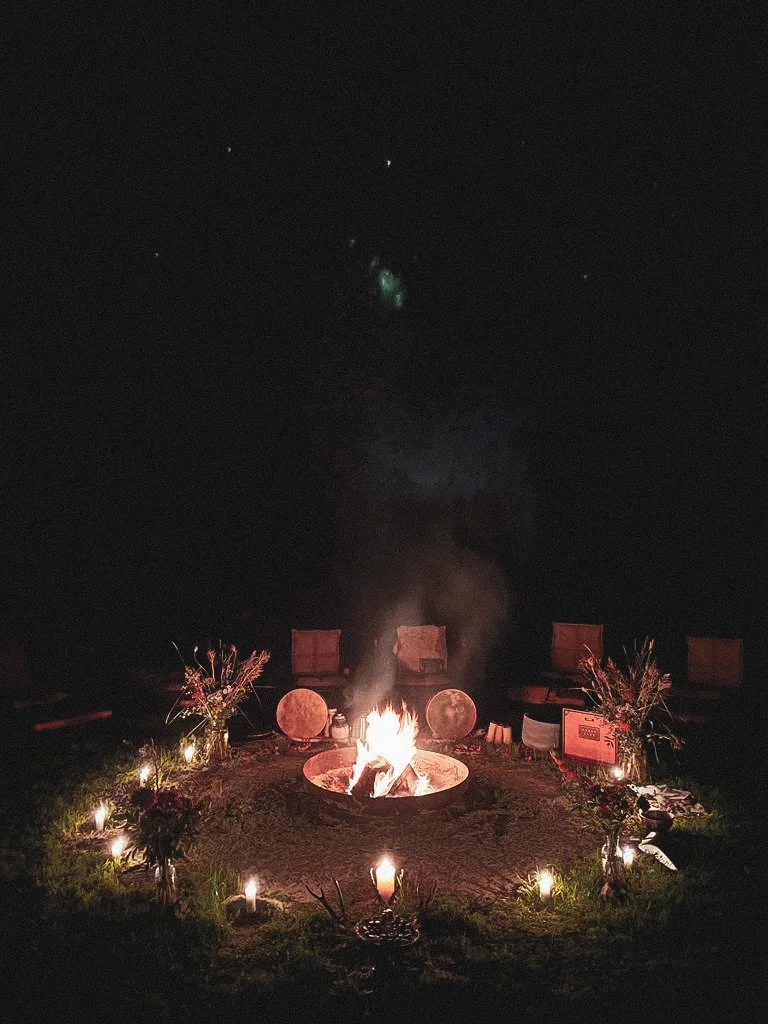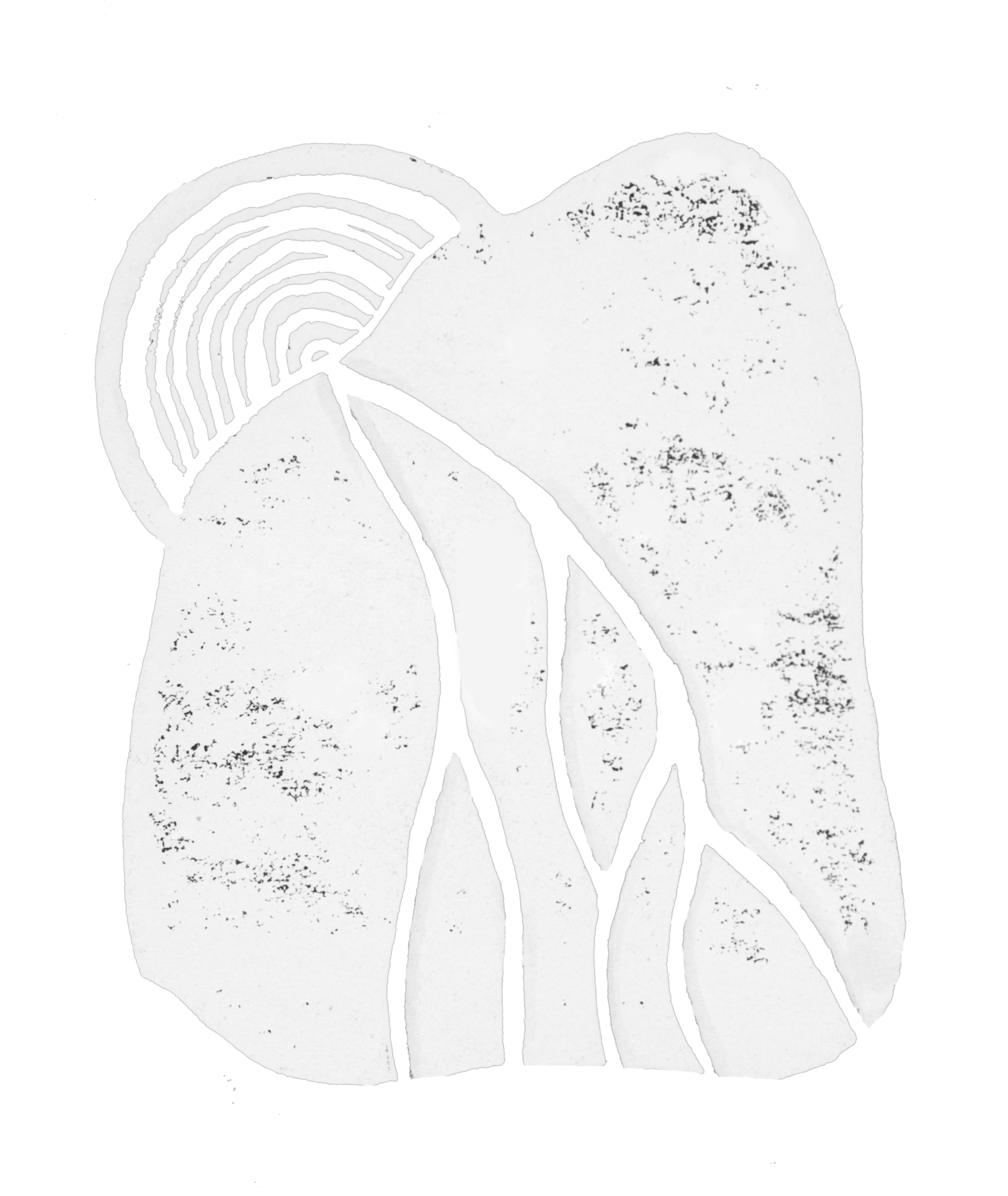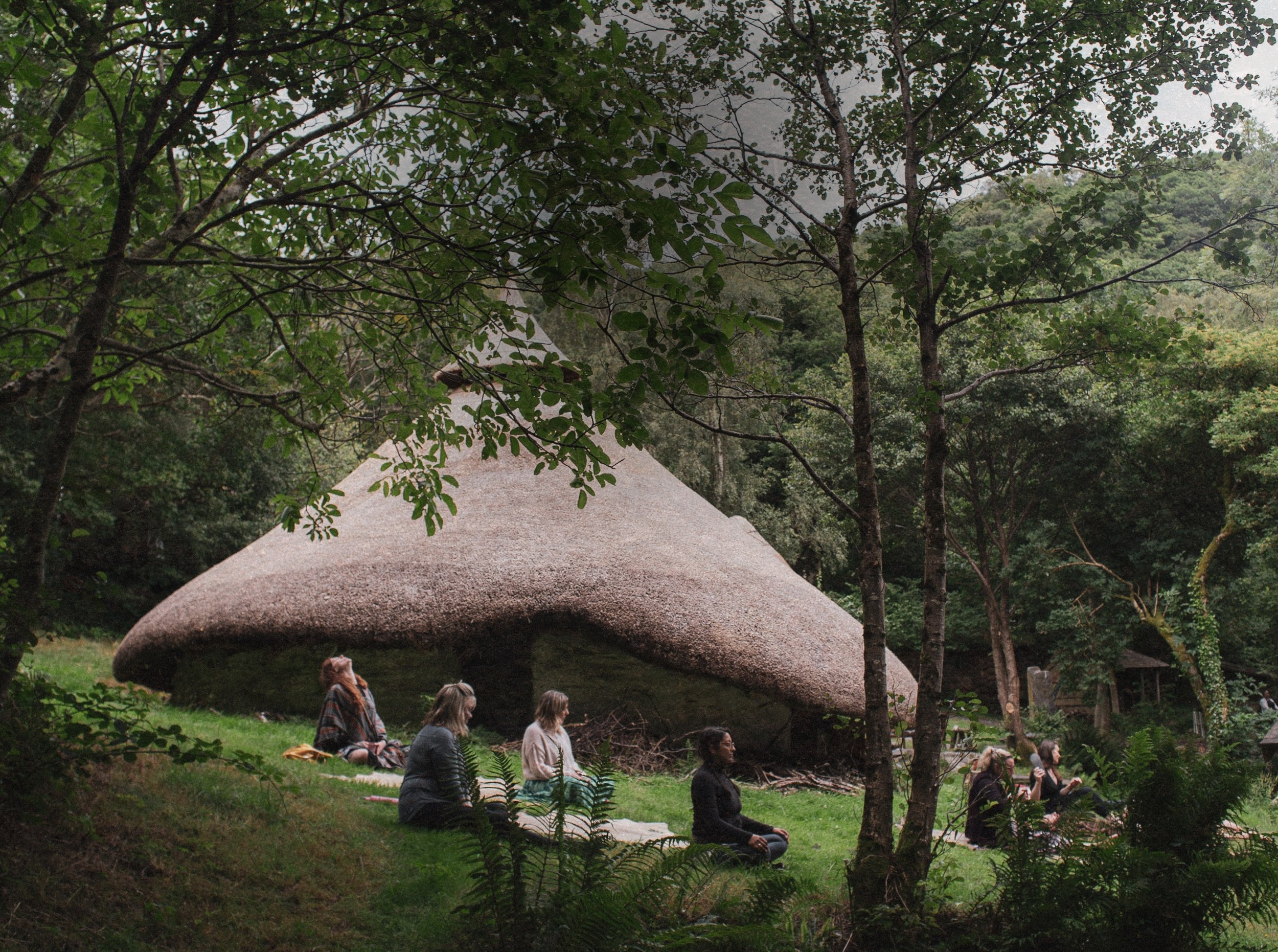
column
The Past, Present + Future of ‘Magic Mushrooms’
Words by VERONICA STANWELL
Weaver of land, ceremony, psyche, song + somatics + founder of Rooted Healing
Abundant by nature, Psilocybin's history is richly dispersed in ancient cultures, with usage dating back thousands of years.
Evidence suggests its presence in various indigenous rituals and spiritual practices across different continents. In ancient Europe, some cave paintings, like those found in the Tassili n'Ajjer caves in Algeria (dating back to around 10,000 years ago), portray a potentially ritualistic relationship between humans and psilocybin. “Here are the earliest known depictions of shamans with large numbers of grazing cattle”, writes ethnobotanist/mystic Terence McKenna in his book Food of the Gods: The Search for the Original Tree of Knowledge. McKenna continues to discuss the figures as dancing with fists full of mushrooms and having “mushrooms sprouting out of their bodies”. In one instance these shapes are surrounded by “the geometric structures of their hallucinations”.
Across Central and South America, indigenous societies, notably the Aztecs and Mayans, revered psilocybin-containing mushrooms as sacred.
The Aztecs referred to them as teonanácatl, translating to ‘flesh of the gods’.
They incorporated psilocybin mushrooms into religious ceremonies, for the cultivation of communication with nature/deities and provided spiritual insights. Some indigenous groups in regions where psilocybin mushrooms grow still incorporate them into traditional rituals and ceremonies, such as the Mazatec and Huichol peoples and others in Central and South America (although less obviously, the notion of indigenous use could be applied to current modern use in many parts of the world, such as Celtic traditional ties in Britain for example).
Threaded through our collective ancestry we can find mythical references and evidence of ritualistic use of mushrooms containing psilocybin, seen as sacred for spiritual and healing purposes.
Such practices aim at accessing expanded states of consciousness (also called ‘higher consciousness’), healing ailments, amplifying collective prayer, and igniting a deeper connection with nature and the spiritual realm (without this language of their constructed severing).
In our more recent history of psilocybin, Maria Sabina, a Mazatec curandera (healer) from Mexico, became renowned for her role in popularising the ritualistic use of psilocybin mushrooms. Born in 1894 in a small Mazatec village in Oaxaca, Maria Sabina grew up in a tradition deeply rooted in indigenous healing practices.
She gained widespread attention in the 1950s when an amateur mycologist and ethnomycologist, Robert Gordon Wasson, sought out a firsthand experience with psychedelic mushrooms. Wasson, along with his photographer colleague Allan Richardson, journeyed to Mexico and eventually found Maria Sabina, who agreed to hold a mushroom ceremony for them.
In June 1955, Wasson and Richardson participated in a velada, a nocturnal mushroom ritual conducted by Maria Sabina. During this ceremony, Maria Sabina ingested psilocybin mushrooms and guided the participants through the experience, chanting and invoking the healing powers of the mushrooms. Wasson documented this transformative experience in an article for Life magazine, introducing the Western world to the existence and potential of these sacred mushrooms.
Sadly (and often overlooked), the publication of Wasson's article brought unintended consequences for Maria Sabina and her community. The increased attention led to a flood of tourists and spiritual seekers to her village, disrupting the sacredness and integrity of the Mazatec rituals. The exploitation of these ancient practices deeply troubled Maria Sabina, as she believed they should be respected and held sacred, not exploited for personal gain or sensationalism. She faced criticism and backlash from some within her community for sharing their sacred traditions with the outside world. Tragically, she was ostracised, her house was burned down, her son was murdered, and she was briefly jailed.
Astoundingly, despite these challenges, Maria Sabina remained dedicated to her healing practice and the preservation of Mazatec traditions. She continued to conduct ceremonies and share her wisdom, emphasising the sacredness and spiritual significance of the mushroom rituals. Maria Sabina passed away in 1985, leaving behind a complex legacy as a revered healer who inadvertently opened the door for the Western world to discover the spiritual and therapeutic potential of psilocybin mushrooms.
As highlighted during our interview with Kirra Swenerton, the Indigenous Medicine Conservation Fund (IMC Fund) focuses on the preservation and revitalisation of ancient plant and fungi medicine traditions, with one area of focus on psilocybin, particularly those of the Indigenous mushroom tribes within the Sierra Madre.
In this pivotal era of psilocybin's resurgence as a frontline medicine, the IMC Fund’s commitment lies in acknowledging and healing the aftermath of the 1960s psychedelic movement, especially the impacts it left on the Mazatec Sierra communities.
Today, the once-unbroken lineages of traditional knowledge regarding the 15+ psilocybin fungus species and their ceremonial uses have significantly diminished. Urbanisation, financial struggles, and a loss of access to ancestral healing methods have challenged indigenous medicine families profoundly. The IMC Fund’s strategy centres on rectifying this disparity by advocating for reparations and benefit sharing for the Indigenous mushroom tribes, ensuring their rightful place within the burgeoning psilocybin industry.
A part of the initial psychedelic frenzy in the West involved influential figures like Timothy Leary who popularised psilocybin use (along with other classic psychedelics), advocating its potential for expanding consciousness and challenging societal norms. However, due to legal restrictions and cultural shifts (anti-racism, feminism, anti-war, anti-establishment and so on), research into psychedelics was largely halted for decades, mostly ‘thanks’ to Nixon’s political ‘war on drugs’. Recently, there's been a resurgence in scientific interest. Current studies explore psilocybin's therapeutic potential, especially in treating mental health conditions like depression, anxiety, PTSD, existential dread due to chronic illness (such as cancer) and addiction (you can explore studies in our collated resources).
Rigorous scientific trials conducted at institutions like Johns Hopkins University and Imperial College London have shown substantially promising results, demonstrating the capacity of psilocybin-assisted therapy to induce profound and positive psychological changes.
Contemporary psilocybin retreats and therapeutic settings offer guided experiences, combining psilocybin ceremonies within therapeutic frameworks, mindfulness practices, and professional support. Settings like our psilocybin retreats Earth Medicine aim to provide safe and structured environments for individuals to explore this ancient medicine’s potential for personal growth, healing, and spiritual development, emphasising integration, community, nature-connectedness and psychological, somatic and practical support before, during, and after the experience.
Ethically and integrally held psilocybin retreats, often referred to as psychedelic or magic mushroom retreats, offer life-changing experiences through the guided and intentional use of psilocybin as a substantial healing medicine and as a doorway to new perspectives, increased creativity and purposeful living in connection with other ways of knowing. Our retreats combine the therapeutic potential of psilocybin with supportive, wilderness-immersed environments (in our opinion, the perfect ‘set and setting’).
We see this work not as individualistic, but as catalytic for collective healing, through both inner (psyche) and outer worlds (community and environment).
learn more about our ceremonial gatherings + psychedelic retreats
We, as human beings upon this earth, have sat in ceremony (in its many forms - plant and fungi medicine ceremonies included) since time immemorial. It is our birthright to cultivate time together to connect with our shared humanity and our relational dance within the web of existence.
Ceremony offers us a healing containment to delve into the depths of our heart’s questions, sorrows, joys and dreams. Safely held and guided psilocybin-assisted experiences provide exploration into the depths of consciousness, allowing deep emotional healing, whilst paving pathways of personal, social and ecological change. These experiences are designed to be transformative, offering profound insights, promoting self-reflection, aiding in the treatment of modern fast-paced-life symptoms and conditions.
Ceremony brings us back into a state of belonging, which balms the losses of the modern era. It is an alchemy of intention, song, prayer and elemental relationship, through which our personal and collective voices of longing and creativity are extended to the unseen dimensions of life, beyond our conscious minds and into the realms of nature and spirit. This act is indigenous to the psyche, invoking a form of ‘direct knowing’, which is often ineffable but experienced through the fabric of our being.
The re-integration of psilocybin within ceremony emphasises its potential to catalyse positive regenerative changes, impacting lives in profound and meaningful ways.
There are concerns about psychedelic integration, since it is such a new field outside of experienced indigenous perspectives. We hold a 4 week preparation programme and a 10 week integration programme, also placing a lot of emphasis on integration within our psilocybin retreat immersions. The real work begins when we step back into our lives, beyond the peak experience. Bringing forth the insights into an embodied change requires active participation, continued self-care and inter-relational understanding.
We envision a powerful future for psilocybin and our ceremonial reclamation with it. The science is showing, again and again, what a catalyst this ally is to our healing and evolution. Films like Fantastic Fungi and Michael Pollen’s ‘How to Change Your Mind’ provide glimpses into a future remedied out of catastrophe with the aid of our fungi kin, of which psilocybin’s role with the human psyche is emphasised and celebrated.
Much of this path is about our individual and collective reclamation of indigenous ways of being with (and of) the world.
When the myth of technological ‘progress’ dominates our social structures, many perceive indigenous wisdom and practices as ‘backward’ or primitive, yet there is a growing interest and reverence for the original threads to our inter-relational existence.
It is through our rekindling relationship with psilocybin that we open new and ancient doorways to our fullest potential as a species rewoven with this Earth, seeing the beauty and feeling ourselves to belong to it, promoting our guardianship of the natural world, of community and of our sovereign holistic practices.
The future of our psilocybin story is ours for the making.
Disclaimer: The content provided in this article about psilocybin is intended for informational purposes only. It does not constitute medical advice, diagnosis, or treatment. Psilocybin and psychedelics, in general, are controlled substances in many jurisdictions and their use, possession, or distribution may be illegal. The effects of psilocybin can vary significantly between individuals and must be approached with caution. Any decision to engage with psychedelics should be made with careful consideration of personal health, legal consequences, and in compliance with applicable laws and regulations.
You can listen to Veronica explore topics such as ceremony, psilocybin, belonging and healing on the Rooted Healing podcast.
Join us at EARTH MEDICINE
experience safe psilocybin ceremonies nestled in ancient coastal forest
continue reading our journal
-

Catalysing Connection: Psilocybin and Biophilia
Of the various psychedelics, psilocybin may have a particular propensity towards kindling a sense of kinship with nature.
-

Rooted Resilience: Why Practice Deep Ecology?
Each one of us has a role to play in the movement toward a world where belonging is the birthright of every human, plant, animal, rock and river.
-

The Past, Present and Future of 'Magic Mushrooms'
Today, the once-unbroken lineages of traditional knowledge regarding the 15+ psilocybin fungus species and their ceremonial uses have significantly diminished.




